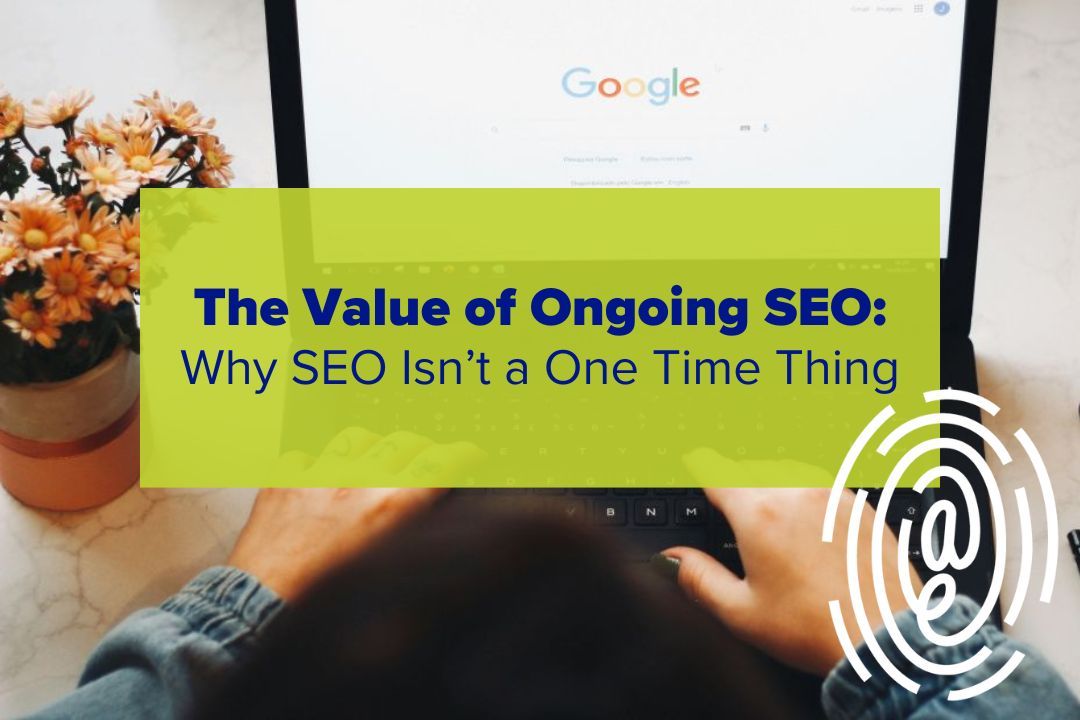
Featured SEO
Sean Flamand
The Value of Ongoing SEO: Why SEO Isn’t a One Time Thing
SEO Is an Ongoing Process, Not Just a One-and-Done Project
One of the biggest challenges we face in providing SEO services is helping clients understand that while SEO is extremely reliable, it takes time to produce results—and the quality of your results often directly depends on how well you stick with your SEO efforts. This is because SEO requires ongoing work and maintenance to ensure the best results.
While some may envision SEO as a one-time project that will have a one-time payoff, this isn’t accurate—or at least, it isn’t the most effective way to do SEO. Businesses should instead think of SEO as an ongoing process of monitoring, optimizing, anticipating, and reacting to drive more traffic.
But the good news? Consistent, ongoing efforts will produce consistent, ongoing results—and more exponential growth.

Is SEO a One-Time Thing?
SEO both is and isn’t a one time thing. Makes perfect sense, right? No? Then I’ll explain!
If you have a new website, or an old one that’s never been optimized for search, there’s a significant amount of upfront SEO work that should be done. This includes strategizing, keyword research, optimization, and setup of data collection resources like Google Search Console and Google Analytics. It may also include more technical elements such as auditing your website’s speed. Completing each of these tasks constitutes a one-time project.
However, while doing all this can and very likely will yield significant returns in terms of search, it should be thought of as a jumping-off point and not the final product. There’s a reason we call our initial SEO package the “SEO Foundational,” as it’s meant to establish a solid baseline—to then continue building from.
Ongoing SEO can do a whole lot more to build your traffic over the long term by adding to those initial results. Not only do you get the results from the initial SEO work, but you also gain insights into what works (and what doesn’t), as well as an initial traffic footprint. We say this often, but traffic begets traffic—that is, as you start to accumulate more search traffic, and users have a good experience on your site, Google is likely to send more users your way.
You can see a great example of how ongoing SEO and SEO maintenance can exponentially build traffic in this case study. For this client, we brought in a 1,200% increase in organic traffic within the first year thanks to the initial round of optimization. Then, they engaged with us for Ongoing SEO and we’ve since doubled their ranking keywords from 1,000 to 2,000.

On the other hand, a client for whom we completed only an SEO Foundational saw excellent initial returns—that sadly tapered off. Their traffic grew significantly after two months, peaked from months 4–6 post-optimization, and slowly declined over the next year or so.

So while one-time SEO efforts can yield significant results, SEO should not be thought of as a one-time thing overall. Just about any business will see much better organic traffic returns by continuing on with ongoing SEO and building on those early gains.
The Advantages of Ongoing SEO
So you’ve seen the potential downsides of investing only in a one-time SEO project. But why is ongoing SEO so advantageous? Here are some of the key advantages to treating SEO as an ongoing process.
You’ll Give Yourself More Chances to Rank
SEO is both an art and a science. (If you’re a client of ours, you’ve likely heard me say this!) What this means is that, while we can make predictions about what will be the best keywords to optimize for, not every prediction will be correct and not every page will drive traffic.
Often, it can feel like the success or failure of a particular optimized page or blog post is partially up to chance—or at least, the whims of Google’s algorithm. But the more content you’re able to optimize with time—whether by adding new content or by optimizing a whole backlog of blog posts on your website—the more chances you have to strike organic search gold.
You Can Make Pivots If Things Aren’t Working
I’ve written previously about factors impacting how long it takes SEO to work, but the bottom line is that SEO is a long-term play. Still, when you’re a business owner making a significant investment of time, money, or both into SEO, you certainly want to see results sooner rather than later.
If you treat SEO as a one-time deal, engaging for an optimization of your website and then leaving things as-is, you’ll almost certainly see results—but they may not immediately be optimal. If you haven’t seen a significant increase in traffic after a few months (typically 3–6), it could be time to pivot your strategy.
One of the advantages of treating SEO as an ongoing process instead of a one-time deal is that you’ll always have the flexibility to pivot and improve on your efforts. When we engage with a client over the long term, we don’t treat our initial round of optimization as set in stone. This is because the Google algorithm is still not fully known—and it’s changing constantly.
Instead, we monitor, evaluate, and look for potential opportunities, especially if a page or post simply isn’t gaining traction—or if it’s gaining traction for a keyword we didn’t expect.
Your Efforts Will Be Continuously More Effective
The more optimized your site is, and the more often you add and edit content, the better your site will rank in search. While optimizing a site that has never been optimized yields significant upfront returns, carrying on with SEO grows more effective with time.
A big reason for this is that Google will trust it more. Sites that are regularly updated and optimized tend to perform better in search. Google doesn’t like sending users to websites that haven’t been touched in months or years. If you’re continuously adding content to (and improving content on) your site, Google will look favorably on it and even begin showing your pages and posts more quickly as you add them.
In addition, gaining early traffic puts you in a better position to earn even more. We often say “traffic begets traffic.” What this means is that, as your site begins to have more visitors, and assuming those visitors have a good experience, Google will send even more traffic your way. In other words, organic traffic tends to have a compounding effect, where the more you get the easier a time you’ll have building that traffic even further.
Key SEO Maintenance Tasks
While you should be continuously adding new high-value content to your website, there are also a few smaller “SEO maintenance” tasks that you can do to help avoid deterioration of your existing traffic. Here are a few key tasks we recommend:
- Know your target keywords – Maintain a keyword list even after you’ve completed baseline optimization on your core website pages. These keywords should align with your business goals and target audiences and will inform much of your optimization efforts moving forward.
- Monitor Google Search Console and Google Analytics – Keep an eye on your traffic and your performance for important keywords. If you notice a sudden drop-off, make sure your site is still performing well technically and assess how you could better optimize pages that are losing traffic.
- Look for keyword pivot opportunities – On your site, you’ll likely have pages that aren’t performing well for target keywords, or pages that are performing very well for keywords you didn’t expect (or both). If it’s been a few months since you’ve optimized, you may consider pivoting your keyword to a new one.
- Review and update content to keep it fresh – As mentioned, Google likes when websites are regularly updated. Refreshing pages or posts by adding new content or updating old information will maintain your trust in the eyes of Google.
- Check for experience issues, like speed or broken links – Broken links are pretty much inevitable on any website. As a good practice, you’ll want to keep an eye out for any broken links and fix them regularly. In addition, as your site gains more content, it may begin to slow down. Monitor the speed of your site and make sure to follow good practices when adding large files like images.
- Make sure your website is mobile-friendly – Google crawls websites on mobile first, which means it’s critical for SEO that your website is responsive. As you review your website’s performance, make sure to look it over on your smartphone as well as your desktop.
- Continuously add new content – The more content your website has, the more opportunities you’ll have to rank. While it can be time-consuming to write blogs yourself, it truly is one of the most essential ongoing SEO tasks you can do to keep building your traffic.
You Don’t Have to Do It All Yourself! Learn More About Our Ongoing SEO Services
At Alter Endeavors, our goal is to help businesses grow through sustainable and efficient lead generation. For many businesses, especially those who provide local services, SEO is one of the most reliable lead generation strategies there is. However, many business owners simply don’t have the time to approach SEO as an ongoing effort and keep up with essential SEO maintenance needs.
That’s where we come in! Our SEO packages are designed to help businesses get found on Google, establish a baseline of high-quality traffic, and continuously build up their organic search presence with time. Whether you’ve never done SEO, or if your SEO efforts aren’t delivering the results you feel you should, request an SEO audit from our team today to get started.
Share
Insights
Read expert marketing insights from our team and get actionable takeaways that will put you on the path to success.

Featured
The Value of Ongoing SEO: Why SEO Isn’t a One Time Thing
Stay Informed
Join our community, where we share marketing insights and celebrate businesses that are making big moves.